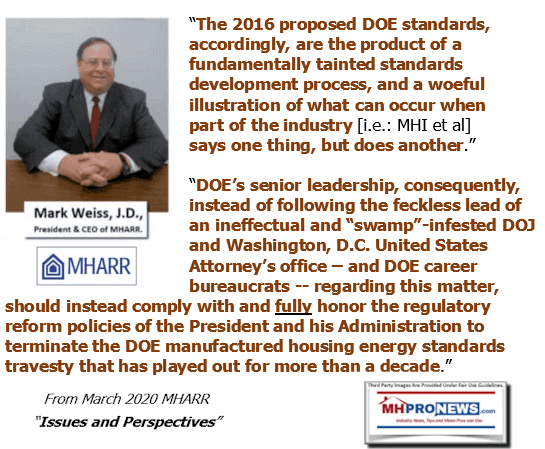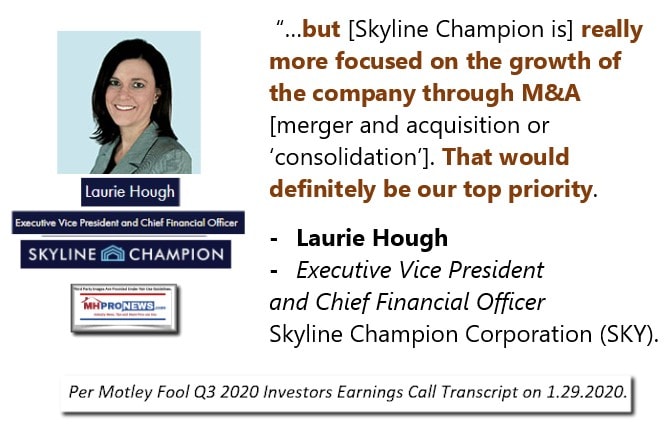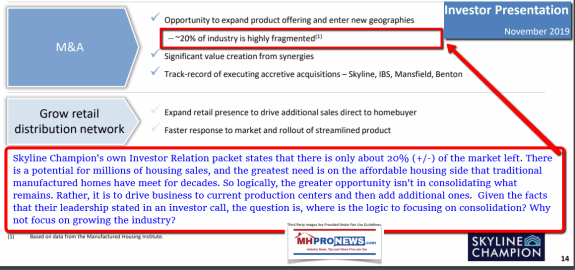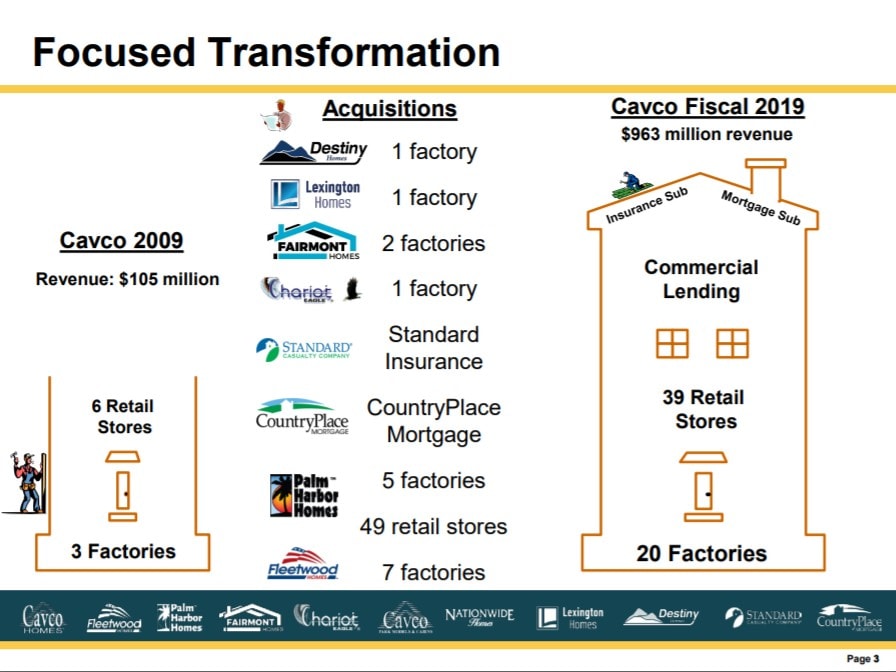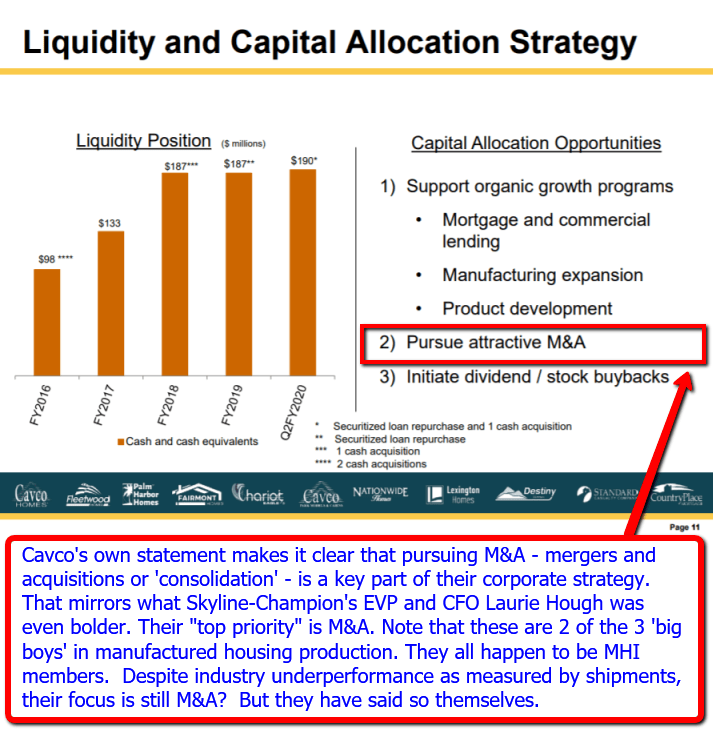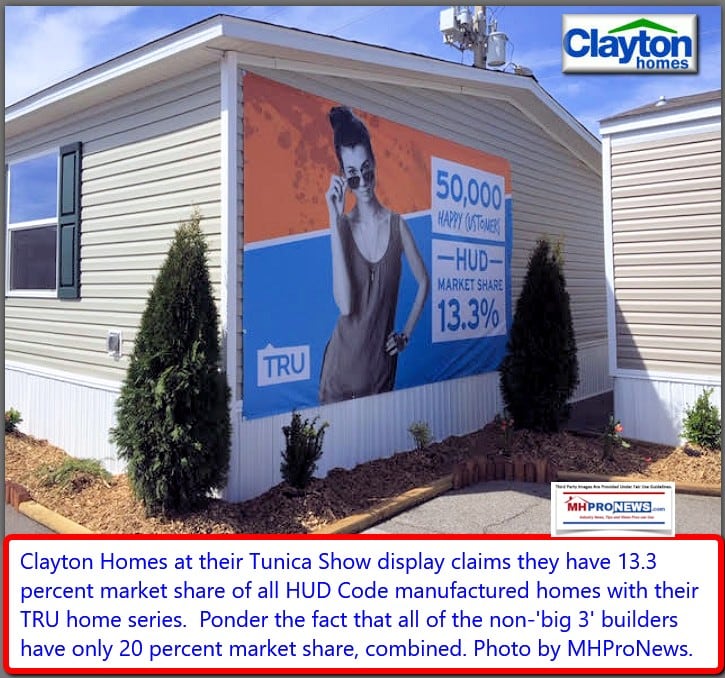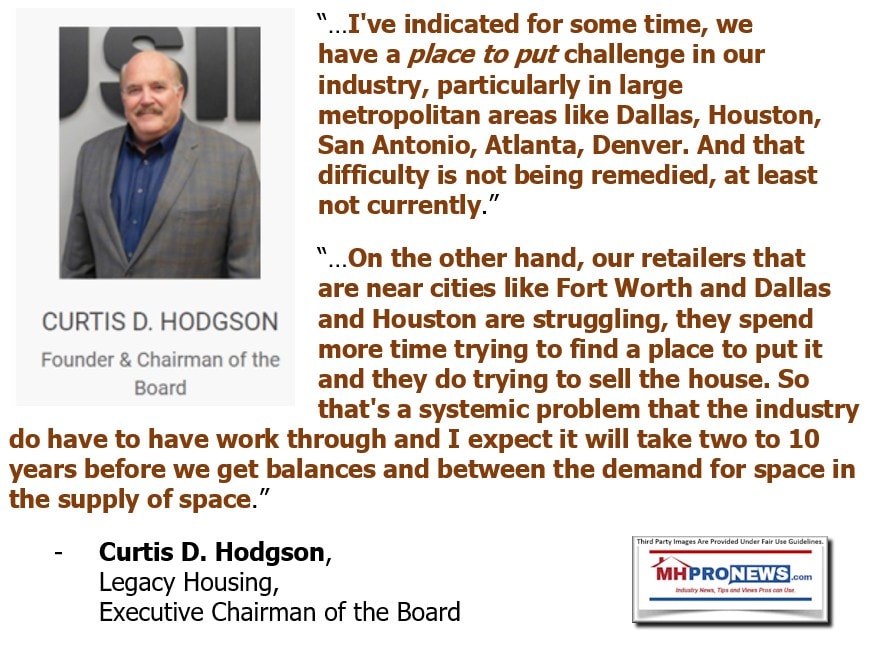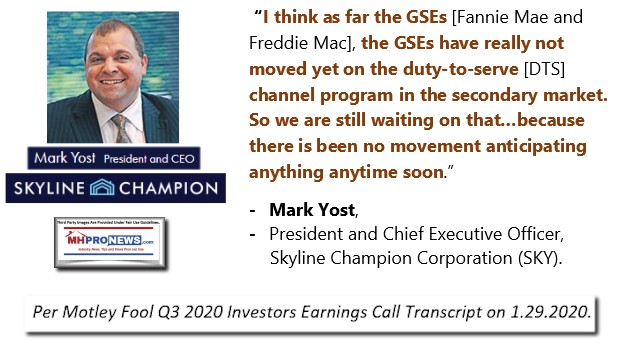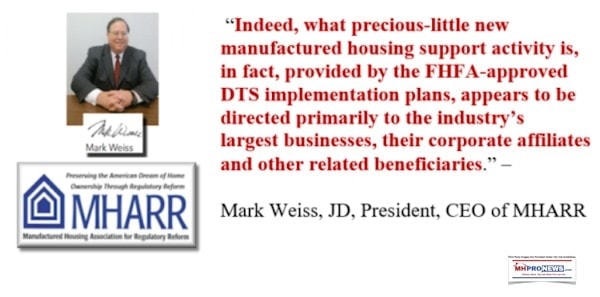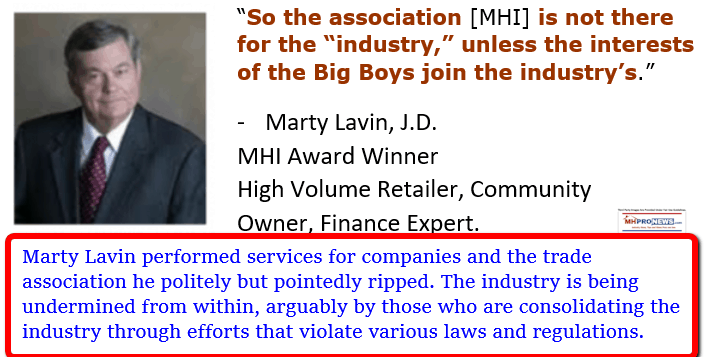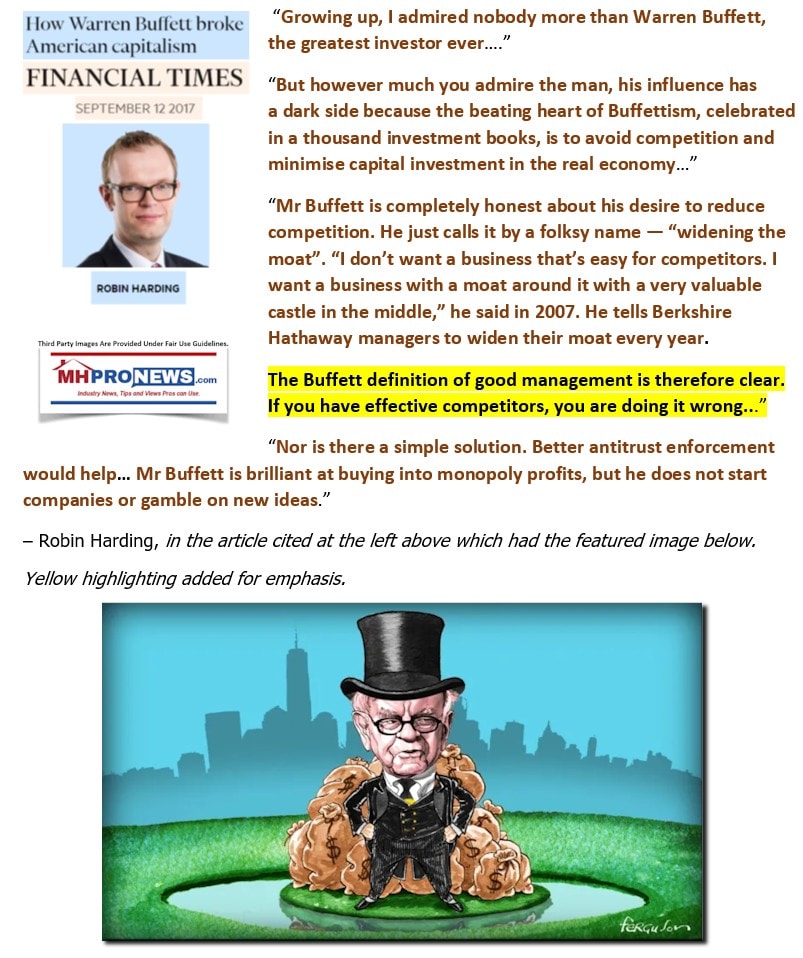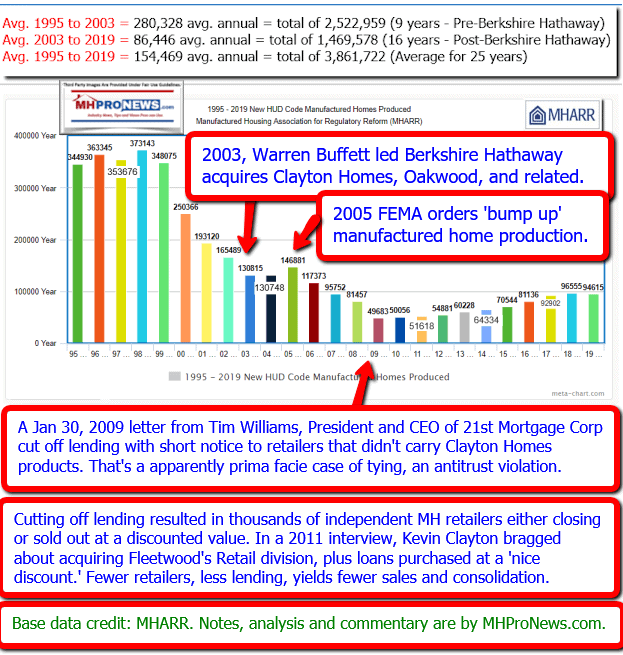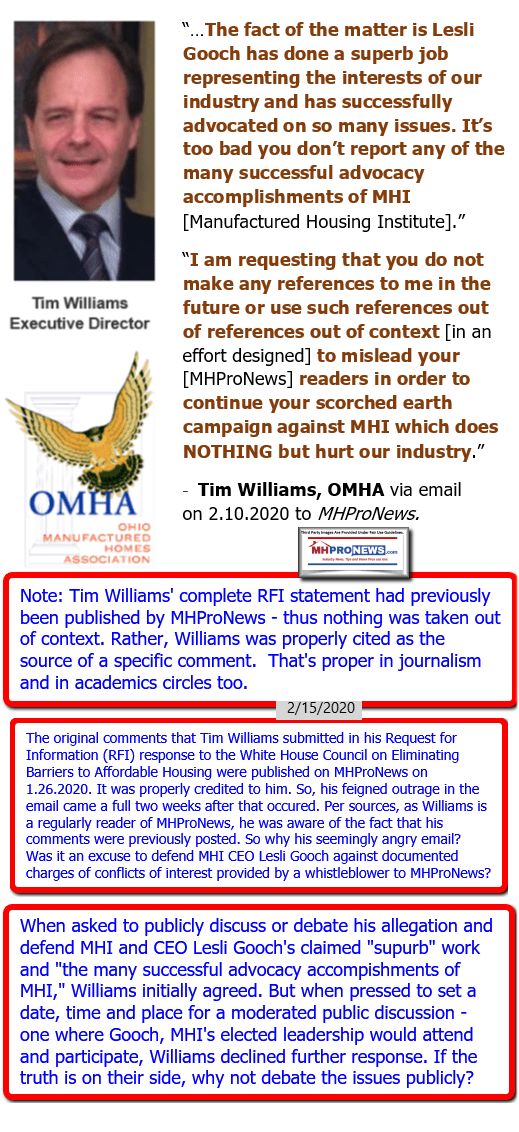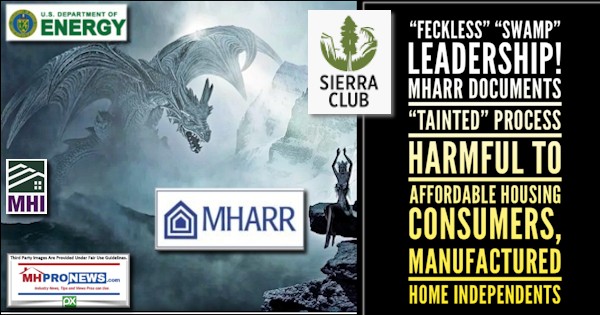
“…all regulation, that excessively impacts small business…In fact,
big companies secretly love regulation because regulations are in fact
anti-competitive — every new rule, law or compliance measure limits
the ability of existing smaller competitors or new start-ups to compete.”
– Carol Roth
– American television personality, bestselling author,
entrepreneur, radio host, and investor. Roth appears
regularly on national cable television networks including
Fox Business, CNBC, CNN, Fox News and MSNBC,
per Wikipedia.
Department of Energy (DOE) standards for manufactured housing have come back into the spotlight as a result of litigation brought by the Sierra Club, which Mark Weiss, J.D., President and CEO of the Manufactured Housing Association for Regulatory Reform (MHARR) takes readers step by step through in his March 2020 Issues and Perspectives.
In a mix of colorful expressions hammered together with facts and evidence, Weiss sticks with the manufactured housing industry side of the insights recounted step-by-step so that it can be followed by industry newcomers who may be unfamiliar with the history of the issues involved. Weiss includes a mention of which organization brought the litigation against the DOE, the Sierra Club. While not mentioned directly, the report linked below should be considered as the rest of the story of how the powers that be in manufactured housing have arguably manipulated the system in a fashion that Weiss details in what below.

Some pull quotes and related commentary from what follows are the punch lines to the industry’s odyssey through the “swamp” of “tainted” regularly rule making. That will be found in an MHProNews analysis and commentary after Weiss’ column. While the entire article is filled with facts that could make the blood of independent HUD Code manufactured home producers and retailers boil, the first line in the opening paragraph is quite colorful and sets the stage for all else that follows.
MHARR — ISSUES AND PERSPECTIVES
By Mark Weiss
MARCH 2020

Like a monster in a B-Grade horror movie that refuses to die, the specter of excessive, discriminatory and extremely-costly federal manufactured housing energy “conservation” standards has emerged once again, this time courtesy of energy special interests and a distinctly un-Trump-like cave-in by the leadership at the U.S. Department of Energy (DOE). As a result, the industry finds itself, once again, faced with the prospect of extreme energy-based regulatory burdens that are not only unnecessary, as shown by extensive federal data, but will simultaneously exclude millions of Americans from the dream of homeownership, directly contrary to President Trump’s affordable housing policies and the express mandate of the White House Council on the Elimination of Regulatory Barriers to Affordable Housing.
The immediate source of this looming threat is a court order issued at the end of 2019 in a federal case filed by the environmental activists at the Sierra Club. The Sierra Club sued former DOE Secretary Rick Perry in the U.S. District Court for the District of Columbia in late 2017, seeking an order compelling DOE to proceed with the adoption of manufactured housing energy standards under section 413 of the Energy Independence and Security Act of 2007 (EISA). DOE moved to have the case dismissed, claiming that the Sierra Club lacked legal “standing” to assert such a claim on behalf of its members. The court, however (in the person of Judge Emmet Sullivan, a Bill Clinton appointee), denied that motion in an order entered on March 12, 2019.
This set up a potential trial on the merits of the case, which MHARR strongly urged DOE to undertake because of the fundamentally corrupted rulemaking process that led to both DOE’s 2016 proposed energy standards rule and the Department’s 2018 revised manufactured housing energy proposal, set out in a Notice of Data Availability (NODA). More on this in a moment. DOE, however, in a practice that was all too commonplace during the Obama Administration – and has inexplicably been carried over to the Trump Administration in this case by some at DOE and the Department of Justice (DOJ) (which ostensibly “defended” DOE in this case) – folded like a cheap suit and agreed to a “Consent Order” which requires DOE to propose manufactured housing energy standards under EISA no later than May 14, 2021, and to adopt final manufactured housing energy standards no later than February 14, 2022.
Whether the standards proposed by DOE under these court-ordered deadlines will be the 2016 proposed standards, the 2018 NODA standards, some variant thereof, or something completely different, is unclear and, indeed, unknown at the current time. Suffice it to say, however, that MHARR has already stressed to DOE in writing that any proposed standards that are linked to, or in any way derived from DOE’s previous fatally-defective rulemaking process in this matter, are – and will be – totally unacceptable and will be vigorously opposed through any and all available means. MHARR, rather, as it has previously asserted, maintains that any new energy standards rulemaking – if pursued at all — must go “back to the drawing board” and begin-over from the start, with a totally new process that is not in any way tainted or impacted by the illegitimate and invalid DOE “negotiated rulemaking” proceeding that led to both the 2016 proposed rule and the 2018 DOE NODA (as established by MHARR in its September 2018 NODA comments).
While the Sierra Club lawsuit, then, is the immediate cause for the impending revival of extreme and discriminatory DOE manufactured housing energy standards which MHARR has previously beat-back time and time-again – and had successfully stifled until they were revived by staff of the Manufactured Housing Institute (see below) — this entire matter is a prime example of a self-inflicted industry wound. And while the full story of the corrupted “negotiated rulemaking” process that followed is set out in detail in comprehensive MHARR regulatory comments filed with DOE in August 2016 and September 2018 (both of which can be found at MHARR’s internet website, www.manufacturedhousingassociation.org), it would be useful to highlight here just some of the deceitful tactics utilized by DOE and its allies in order to advance extreme and unnecessary manufactured housing energy regulation.
Put simply, DOE energy regulation, as of early 2014 – well beyond the five-year EISA deadline for the adoption of DOE manufactured housing energy standards — was going exactly nowhere. MHARR — which had been successful in attaching language to EISA section 413 requiring public notice and comment on any DOE-proposed energy standards and prior review by the Manufactured Housing Consensus Committee (MHCC) — through pressure on HUD, DOE and the MHCC, was able to keep new federal energy standards stalled at DOE, which had gone through multiple fits and starts on a “draft” proposed rule. In fact, the entire issue had all but disappeared from the regulatory and MHCC landscape until the then-MHI Regulatory Affairs Vice President, together with specific named energy special interests, in May 14, 2014 and May 28, 2014 communications to DOE, revived the entire matter, calling for DOE to undertake a “negotiated rulemaking” to “develop” federal manufactured housing energy standards pursuant to EISA, with “a tight meeting schedule” and “a minimum [number] of meetings” despite the highly-technical and cost-intensive nature of those regulations. As a result, a DOE energy rulemaking that had been stagnant and, as later learned by MHARR, had produced a “draft” proposed rule that had been rejected by the Office of Management and Budget’s Office of Information and Regulatory Affairs (OIRA), was effectively re-started and revitalized with the help of part of the industry.
What then followed – as was extensively reported by MHARR at the time – was a sham “negotiated rulemaking” dominated by MHI-member participants and energy special interests, which utilized non-public data inputs to produce a “term sheet” incorporating supposedly “new” recommended energy standards after only a few months of highly-truncated deliberations. What was never disclosed by DOE, however, and had to be unearthed by MHARR through multiple Freedom of Information Act (FOIA) requests, was a pattern of deceit and manipulation of the supposed “negotiated rulemaking” process by DOE, to produce the result that DOE officials and its special interest allies wanted.
This manipulation included, but was not limited to: (1) collusion by DOE with its special interest allies to produce a “draft” manufactured housing energy standards rule in 2011 with no public input; (2) the “impermissible” leak of that “draft” proposed rule (as characterized by DOE’s Office of General Counsel) to DOE’s special interest allies; (3) failure to disclose that “draft” rule or inputs received from special interest allies; (4) failure to disclose the “impermissible” leak of the 2011 draft rule despite requests by MHARR; (5) failure to disclose either the existence of the 2011 “draft” rule or its rejection by OIRA; (6) failure to disclose a directive by OIRA to “start-over” the entire DOE manufactured housing energy rulemaking process; (7) failure to disclose surreptitious coordination between DOE and its special interest allies to conduct a contrived “negotiated rulemaking” process in order to effectively circumvent OIRA’s “start-over” directive; and (8) failure to disclose surreptitious DOE coordination with its special interest allies to establish a “negotiated rulemaking” working group dominated and effectively controlled by “insider” selective leak recipients in order to produce a proposed rule consistent with DOE’s desired outcome.
And, just in case its blatant manipulation of the so-called “negotiated rulemaking” process – stacked with DOE special interest allies – did not work, DOE, in a plot described in various public documents, worked with the part of the industry to manipulate industry opinion in favor of national DOE energy standards for manufactured homes. This was fueled by the award, by DOE and various DOE sub-entities, of more than $1 million in supposed “research” contracts to an MHI-affiliated “research” organization.
In the end, the DOE “negotiated rulemaking” working group wound-up approving a “term sheet” of proposed manufactured housing energy standards that, according to MHARR calculations provided to the working group, would have added as much as $6,000.00 to the retail cost of a new multi-section manufactured home – costs that (as later confirmed by the George Washington University Regulatory Studies Center) could not begin to be recovered by a manufactured homeowner over the typical ownership period of a new HUD Code manufactured home. And that astronomical figure did not include costs related to testing, enforcement and regulatory compliance, because standards relating to those matters were not addressed or developed by DOE until after its 2016 proposed rule was published. Consequently, the cost of any final rule based on the working group’s term sheet, would have far exceeded even the $6,000.00 per home cost estimated by MHARR. Yet, astoundingly, only MHARR voted against the working group’s recommended term sheet, while MHI and all of its members voted to approve the recommended standards (with just one abstention).
The 2016 proposed DOE standards, accordingly, are the product of a fundamentally tainted standards development process, and a woeful illustration of what can occur when part of the industry says one thing, but does another. Further, they were not, have not and cannot ever be “cured” by any subsequent means or measure(s). As a result, they must never be revived or used as the basis for any action by DOE on this matter. And, insofar as the 2018 NODA proposal, by its express terms, was based on “data” developed and “analyzed” as part of the tainted “negotiated rulemaking” process, that proposal, as well, is fundamentally and inherently flawed and cannot form the basis for any legitimate standards proposal going forward.
And all of this does not even begin to address the overriding fact that, according to U.S. Census Bureau data, median monthly energy costs for HUD Code manufactured homes, constructed in accordance with existing HUD standards – including existing HUD energy standards – are already lower than site-built homes for both heating oil and piped natural gas, and only slightly higher for electricity. DOE manufactured housing energy standards, accordingly, would be a purported solution (and not even a good or cost-effective one at that) in search of a “problem” that simply does not exist.
Any revival of this proceeding, therefore, whether ordered by a court or not, would be totally inconsistent with the regulatory reform policies of President Trump and in violation of the regulatory reform Executive Orders (EOs) which have been the hallmark of his administration in the regulatory arena (including Executive Orders 13771 and 13777, and EO 13878, which created the White House Council on Eliminating Regulatory Barriers to Affordable Housing). DOE’s senior leadership, consequently, instead of following the feckless lead of an ineffectual and “swamp”-infested DOJ and Washington, D.C. United States Attorney’s office – and DOE career bureaucrats — regarding this matter, should instead comply with and fully honor the regulatory reform policies of the President and his Administration to terminate the DOE manufactured housing energy standards travesty that has played out for more than a decade.
Meanwhile, the entire industry needs to shake off the impact of years-worth of misinformation spread by DOE and its special interest allies regarding manufactured housing energy standards, and firmly reject the entire

concept of discriminatory DOE manufactured housing energy standards that will cause major harm to both the industry and American consumers of affordable housing. MHARR, for its part, has already communicated with new DOE Secretary Dan Brouilette, calling on DOE to put aside this travesty and to address the issue of manufactured housing energy standards as a regulatory reform issue. Put simply, manufactured homes are already energy efficient. The last thing that either consumers or the industry needs (as noted already by the MHCC) is high-cost energy standards with regulatory compliance costs that cannot be recovered by homeowners over the ownership period of the typical mainstream HUD Code home.
Mark Weiss
MHARR is a Washington, D.C.-based national trade association representing the views and interests of independent producers of federally-regulated manufactured housing.
##
MHProNews Analysis and Commentary
As promised in the introduction to his column, the following are pull-quotes from Weiss’ Issues and Perspective. As is our custom on many quotes, MHProNews turns them brown and bold for emphasis and to make them ‘pop,’ but the words are those of the source quoted. But we start first with a reminder of this quote from Carol Roth, and supporting data that makes her point from the National Association of Manufacturers (NAM). Interwoven as they should be, it paints a complete picture that supports Weiss’ concerns as they specifically relate to manufactured housing.
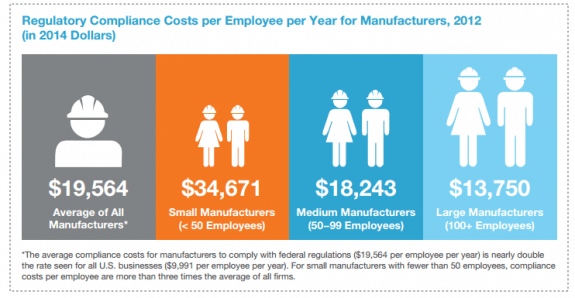
MHI is mentioned by name in his commentary, but savvy professionals must ever bear in mind that MHI is arguably nothing more than a front for the most powerful companies in manufactured housing. While claiming to represent all segments of the industry, the DOE energy standards is just one more example of how MHI is purportedly a tool for consolidation. With already some 80 percent of production in the grasp of just 3 companies, what does one of the ‘big three’ in MHI say is their number one goal? Consolidation of more of the remaining 20 percent.
That is their executive vice-president and CFO’s Laurie Hough’s words, not MHProNews’ or any other person’s mere opinion. To make it clear that Hough was not engaged in mere hyperbole, the point she made in the quote above is repeated in the Skyline-Champion Investor Relations package.
To make it even more plain, another ‘big three’ MHI member firm – Cavco Industries (CVCO) – proudly makes a similar point, only they use different language in their investor relations package.
Rephrased, the big three MHI producing member firms are not even hiding their stategy, they make it plain for the public, investors or investigators willing to open their eyes and see what has been occuring in manufactured housing for over 15 years. Ponder how Warren Buffett acolyte Kevin Clayton put it in a video interview with the transcript of that video linked here.
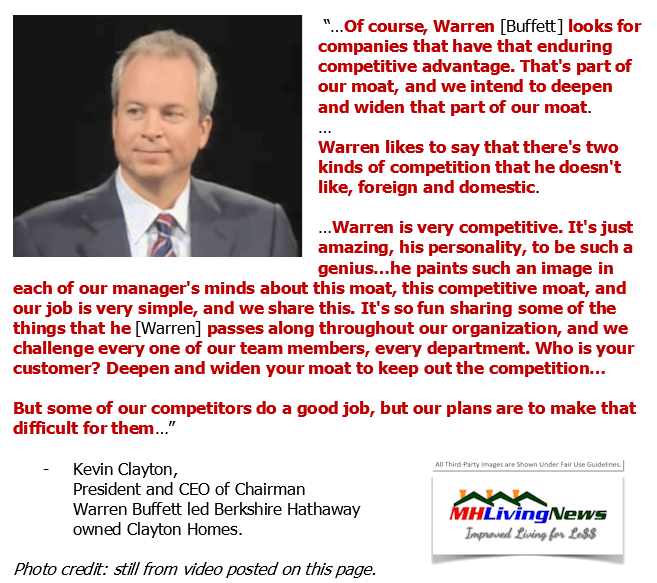
While some companies, Adventure Homes comes to mind among MHI members, may at some point wish to be absorbed into a larger ‘family’ of brands, what independent producers must recognize is that the Buffett “Moat” mantra and purportedly been deployed some years ago in manufactured, per statements like the one cited above by Kevin Clayton, President and CEO of Clayton Homes. This multifacted strategy has included various kinds of tactics using regulations that MHI has often been ‘ineffective’ at stopping, has de facto or even openly supporting. Put differently, MHI is in this context arguably a front group that postures regulatory relief for their members while their large dominant members make sure that the opposite is in fact occuring.
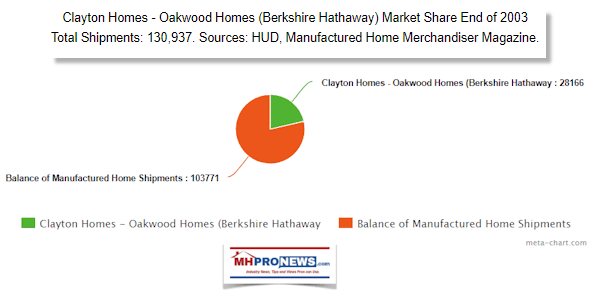
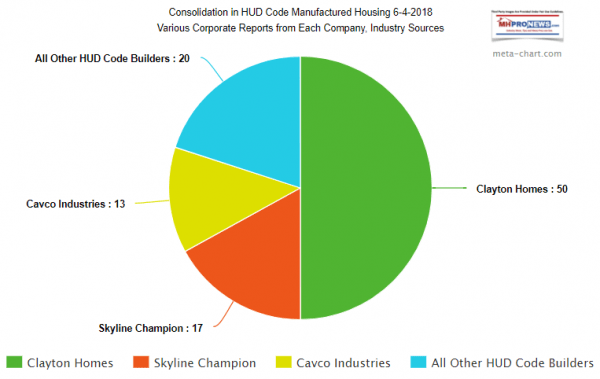
The history of the twisted and tortured efforts by MHI and their surrogates to adopt energy regulations that would bar hundreds of thousands, if not millions, of potential consumers from the chance at home ownership is illustrated in the report linked below.
Electrifying Price Hikes Threatened; Manufactured Housing DOE Energy Rule Controversies Heat Up
What several years of carefully documented research has revealed, and this DOE energy standards episode has once more underscored, is this. There are any number of ways that Berkshire Hathaway owned brands, often acting in concert with others that may at various times use MHI as cover, arguably undermine the interests of manufactured housing independents. Among them is financing, placement and other issues. While MHI and their toadies tout ‘progress,’ a more sobering view is offered in this statement by MHI member Curt Hodgson, Chairman and co-founder of Legacy Housing in a statement made by the publicly traded firm’s leadership.
On the finance side of the industry’s issues one should ponder these quotes, one by an MHI member-leader Mark Yost of Skyline-Champion (SKY) and the second that has for years made the same claim; namely, MHARR’s Mark Weiss.
MHLivingNews carefully documented the various comments by industry residents and professionals in and out of manufactured housing in the report linked below that hammers home the same points made by the quotes above.
No Title
No Description
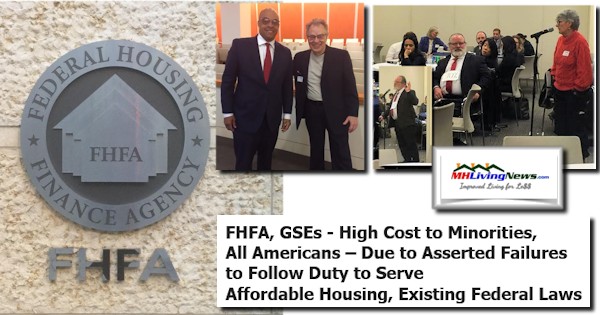
For years, when manufactured housing industry independents finally get tired of the regulatory fight that MHI postures efforts to mitigate against, but which Weiss and others have revealed are a posturing farce, who do they normally sell out to in MHVille? The evidence is clearly that they routinely sell to larger company – which are often MHI members? The case is made by the evidence cited and linked herein the MHI regulatory relief efforts is merely posturing. Their own award-winning retired member Marty Lavin suggested as much.
Given that the industry is underperforming, aren’t the sales of business being made logically at a depressed valuation? Doesn’t all of that happen to conveniently fit Warren Buffett’s own words? Words that Kevin Clayton has said he and his team faithfully follow?
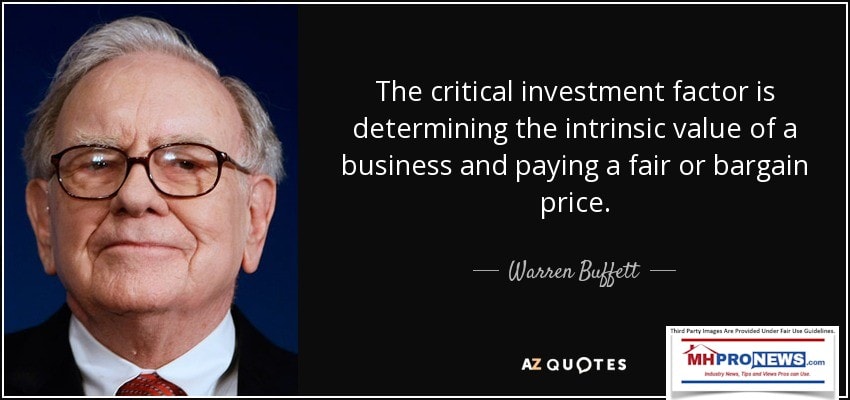

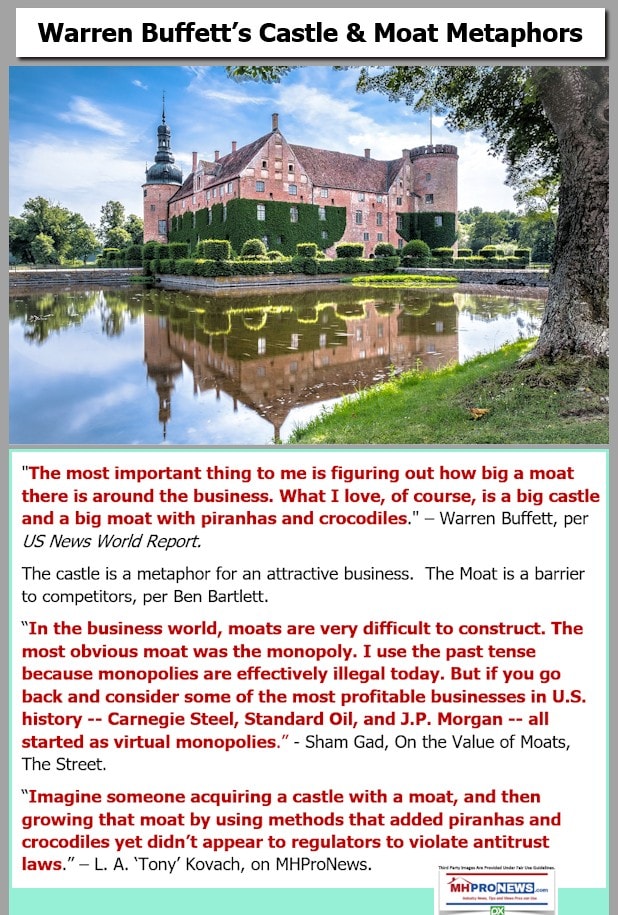
In defense of these allegations, MHI and their puppet masters periodically offer photo ops and pretty-looking messaging that promise somewhere in the murky future regulatory relief which never seems to come.
Or, they trot out a surrogate to ‘defend’ them, when their surrogates claims are easily refuted. The example below is a recent illustration of that point. If MHI CEO Lesli Gooch was doing such a “superb” job, then why is the industry struggling during an affordable housing crisis.
A source with an MHI member producer has told MHProNews that they see the possibility that the coronavirus could be used at some point as a reason to shut down production centers.
The investments of untold thousands of independently owned businesses mostly outside of manufactured housing are already impacted by this coronavirus response, and that during a business-friendly administration. What could happen under a regulatory friendly administration than President Trump has been?
Concerns expressed by manufactured home professionals, which include MHI members, include the notion that this virus has been overhyped. Is there evidence for that? Ponder what the Surgeon General has said, who stated that the risk for most Americans is low, and the recovery rate is high.
“And so, what we want most of America to know is that you’re not at high risk for getting coronavirus, and if you do get it you are likely to recover. Ninety-eight, 99 percent of people are going to fully recover,” U.S. Surgeon General Dr. Jerome Adams said. While this is still a developing issue, with claims made across the spectrum, there are those voices that say that the normal flu has far more deaths annually that what COVID19 may produce. At no other time in modern history has so much attention been paid to a virus to a point that in some nations and parts of the U.S. economy have been shut-down.
Thus, while there are various perspectives on just how serious the coronavirus is compared to other such ‘pandemics,’ never before has so much of the economy been impacted by virtue of governmental fiat. At a minimum, in a free society, that merits scrutiny.
In the context of the MHARR commentary, is this just one more example of how a few uber-rich and highly connected billionaires and their corporate and nonprofit interests can manipulate wide portions of the economy? What does that signal for the smaller business and the American Dream?
So, to MHProNews there is an argument to be made that the DOE energy case is just one more example of a broader mosaic of such issues that could include the twisting of the Duty to Serve manufactured housing in lending, failure to properly enforce the “enhanced preemption” clause or other portions of the Manufactured Housing Improvement Act (MHIA) of 2000, and more.
There are several issues inside and outside of manufactured housing that are seemingly coming to a head. When stocks – and thus investment values – have suddenly plummeted after three years of steady climbs to record highs, it all begs for vigilance and skepticism toward the powers that be that pull the strings from behind the curtains.
For independents, consumers, and investors – it is your profession, future and money that are at risk. See the linked and related reports above and below the byline for more.

See the related reports below the byline for more insights and context. That’s a wrap for this installment of manufactured housing “Industry News Tips and Views Pros Can Use“ © – MHVille’s runaway #1 news source, where “We Provide, You Decide.” © (News, fact-checks, analysis, and commentary.) Notice: all third party images or content are provided under fair use guidelines for media. 
Submitted by Soheyla Kovach for MHProNews.com. Soheyla is a co-founder and managing member of LifeStyle Factory Homes, LLC, the parent company to MHProNews, and MHLivingNews.com. Connect with us on LinkedIn here and here.




